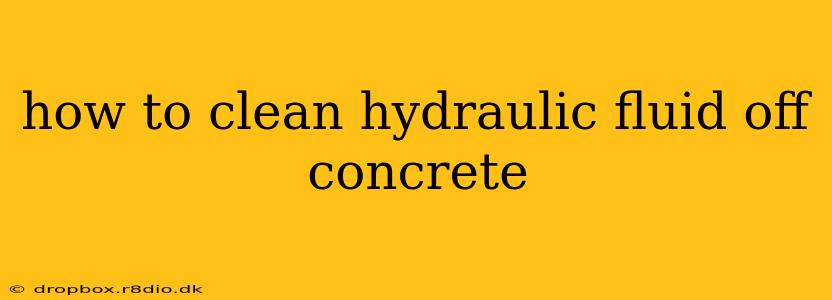Hydraulic fluid spills on concrete can be a messy and potentially hazardous situation. This comprehensive guide will walk you through the safest and most effective methods for cleaning up hydraulic fluid, ensuring both your safety and the longevity of your concrete surface. We'll cover everything from initial containment to final cleanup, providing you with the knowledge to tackle this task effectively.
Understanding the Challenges of Hydraulic Fluid Cleanup
Hydraulic fluid, often composed of petroleum-based oils, presents unique challenges when it comes to concrete cleaning. Its viscous nature makes it difficult to remove completely, and improper cleanup can lead to staining, slipperiness, and environmental concerns. The key is to act quickly and use the right materials and techniques.
Safety First: Protecting Yourself
Before you begin any cleanup, prioritize your safety. Hydraulic fluid can be irritating to the skin and eyes, and some formulations may be toxic. Therefore, always wear:
- Gloves: Heavy-duty chemical-resistant gloves are essential.
- Eye protection: Safety glasses or goggles will protect your eyes from splashes.
- Respiratory protection: A respirator may be necessary for large spills or in poorly ventilated areas.
- Appropriate clothing: Cover as much skin as possible to avoid contact with the fluid.
Step-by-Step Cleaning Process
The cleaning process depends on the size and nature of the spill. Here's a breakdown of how to handle different situations:
1. Containment and Absorption
- Small Spills: For small spills, use absorbent materials like kitty litter, sawdust, or oil absorbent pads to soak up the fluid. These materials will bind to the oil, making it easier to remove.
- Large Spills: For larger spills, contain the spread using absorbent booms or dams to prevent further contamination. This will also make cleanup more manageable.
2. Removal of Absorbent Material
Once the absorbent material has absorbed the hydraulic fluid, carefully collect and dispose of it properly. Never dispose of contaminated materials in regular trash. Check with your local waste management facility for proper disposal guidelines. They often have specific procedures for hazardous waste.
3. Cleaning the Concrete
After removing the absorbed material, you can clean the remaining residue. The method you choose will depend on the type of concrete and the extent of the staining.
- Mild Soapy Water: For minor spills and light staining, a solution of mild detergent and warm water may suffice. Scrub the area thoroughly with a stiff-bristled brush, and rinse thoroughly with clean water.
- Degreasers: For more stubborn stains, consider using a commercial degreaser specifically designed for oil and grease removal on concrete. Always follow the manufacturer's instructions carefully.
- Pressure Washing: For larger areas or heavily stained concrete, a pressure washer can be very effective. However, use caution to avoid damaging the concrete surface. Start with a lower pressure setting and gradually increase it if necessary.
4. Final Rinse and Drying
Once you've completed the cleaning process, rinse the area thoroughly with clean water to remove any remaining cleaning solution. Allow the concrete to dry completely before returning to normal use.
Preventing Future Spills
Prevention is key when it comes to hydraulic fluid spills. Regular maintenance of hydraulic equipment, proper storage of fluids, and designated spill containment areas can significantly reduce the risk of accidents.
Note: For large spills or if you're unsure about the proper cleanup procedure, contact a professional hazardous waste cleanup company. They have the expertise and equipment to handle the situation safely and effectively.
This comprehensive guide offers a detailed approach to cleaning hydraulic fluid from concrete. Remember that safety is paramount, and proper disposal is crucial for environmental protection. Following these steps will help you effectively clean the spill while minimizing risks and potential damage.

